In July it becomes evident whether your avocado tree will have a crop to eat next year. Do you see small avocados on the tree now? Do you see many?
If your answer to either question is no, then this post should give you a clue as to why not. If you have an avocado tree that has never made fruit, or that has never made much fruit, or that has no fruit this year, I’ll help you understand why. And of course, I’ll share ideas on how to improve the situation.
Did the tree flower?
First, during the spring, did your avocado tree make flowers? If it did not, then there was no hope for fruit this year. In general, avocado trees flower once per year, and this mostly happens in the spring. So if your tree didn’t make flowers this past spring, then you must wait with hope for next spring. If your tree did flower, then it had a chance to make avocados, as the fruit comes from the flowers.
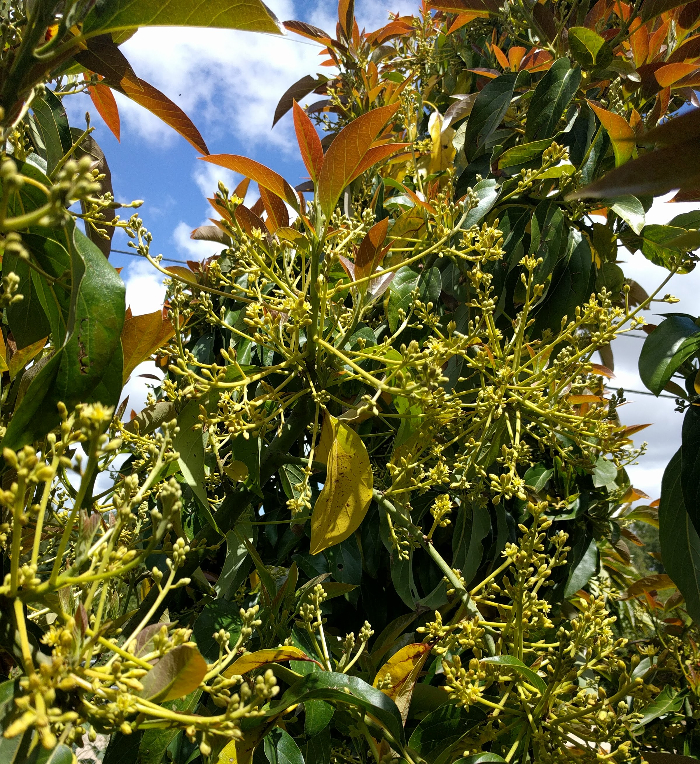
Let’s start by looking into trees that make flowers but don’t end up with avocados, or at least don’t end up with many avocados. Later we’ll look into trees that don’t make flowers.
YES, THE TREE FLOWERED
There are seven main reasons that an avocado tree will make flowers and yet not make avocados.
Fuerte
The first one is that the tree is a Fuerte. Alas, the Fuerte variety is well known to include individual trees that are barren. I have experienced this firsthand: I have an eight year-old Fuerte that flowers abundantly every year and yet has never produced a single full-sized avocado. I have also seen numerous other Fuertes in varied locations throughout Southern California that are drones as well. (More on this in my profile of Fuerte.)
What’s wrong with these Fuertes? In short, they have defective flowers. (Details in my post on avocado cukes.)
B types
Fuerte is a B-type avocado, and that means its flowers become female in the second half of the day. There are lots of other B-type avocado varieties, such as Zutano, Sharwil, Bacon, Ettinger, and Edranol. On the whole, B-type avocado varieties are not as productive as A types, especially in locations that have chilly nights or low average temperatures overall. (See this paper by Peter Peterson.)
I’m in such a location (chilly nights), and my B-type avocado trees don’t produce as well as my A types. Nevertheless, some B types are consistently more productive than others. I’ve found that Edranol produces well in my yard, for instance.
As another example, Ellen Baker and Freddy Menge of Epicenter Avocado Nursery near Santa Cruz are in a cool coastal location and they have also found that A types produce better than B types, in general. Yet Zutano is a good producer on their property. (Read more about their results with Zutano and other B types here.)
Some other B types might produce well in years when the spring weather is warmer than normal, but have no crop in cool springs. Sharwil is a variety that has frustrated many with such a fickle fruiting habit, which is at least partly related to temperatures during bloom. Sharwil is particularly frustrating in this respect because its avocados are among the finest in eating quality.
(See this study from Australia showing Sharwil’s sensitivity to low temperatures during bloom.)
If you have a B-type avocado tree that isn’t producing fruit in your yard after more than about five years, I would cut your losses and remove the tree and replant with an A type or graft it over to an A type.
Help of a pollenizer
Every avocado variety that I know will produce fruit as a lone tree. In other words, you do not need two avocado trees to get fruit. That said, every avocado variety that I know will produce more fruit if there is another avocado variety in bloom at the same time near it.
So this is something to consider if your avocado tree is flowering and making a little fruit but not as much as you think it could. Although adding a pollenizer tree can increase fruit production, do note that it won’t make a barren tree fruitful (as far as I’ve ever seen or read).
(Check out these papers with remarks on the cross-pollination effects on the following varieties: Hass, Fuerte, Pinkerton, Gwen.)
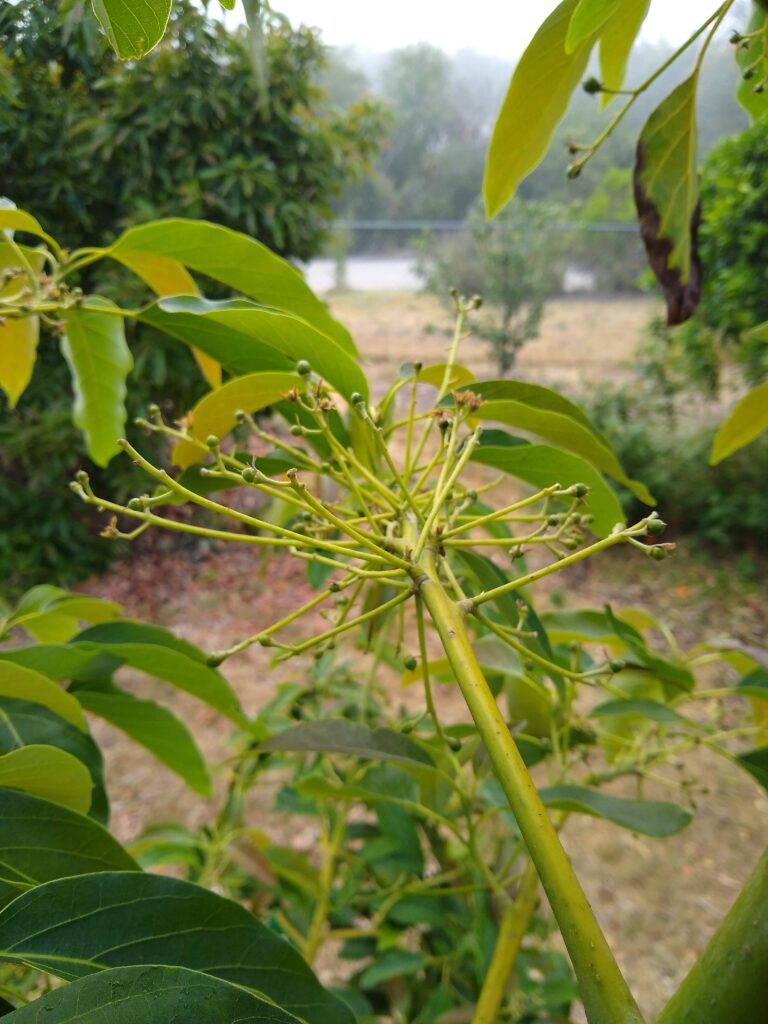
Not enough flowers
Your avocado tree flowered in the spring, but did it flower a lot? Avocado trees are unskilled at turning their flowers into fruit compared to most other fruit trees. Peaches can turn almost every flower they make into a peach, but in contrast, avocado trees end up shedding most of the flowers they make.
Back in 1960, the University of California’s avocado breeding program was located in Los Angeles, and there they found that through hand pollination they usually had about a one percent success rate. That is, for every hundred flowers pollinated, they usually got a single avocado. Sometimes they only got one avocado out of one thousand flowers. (See this report by Shroeder in the 1960 California Avocado Society Yearbook.)
Therefore, if your tree made only a few hundred flowers this spring, which might seem like a lot, you still ought not expect a bunch of avocados.
One reason an avocado tree flowers only mildly — and then sets few fruit — is if it isn’t getting enough sun. More sun equals more flowers equals more avocados.
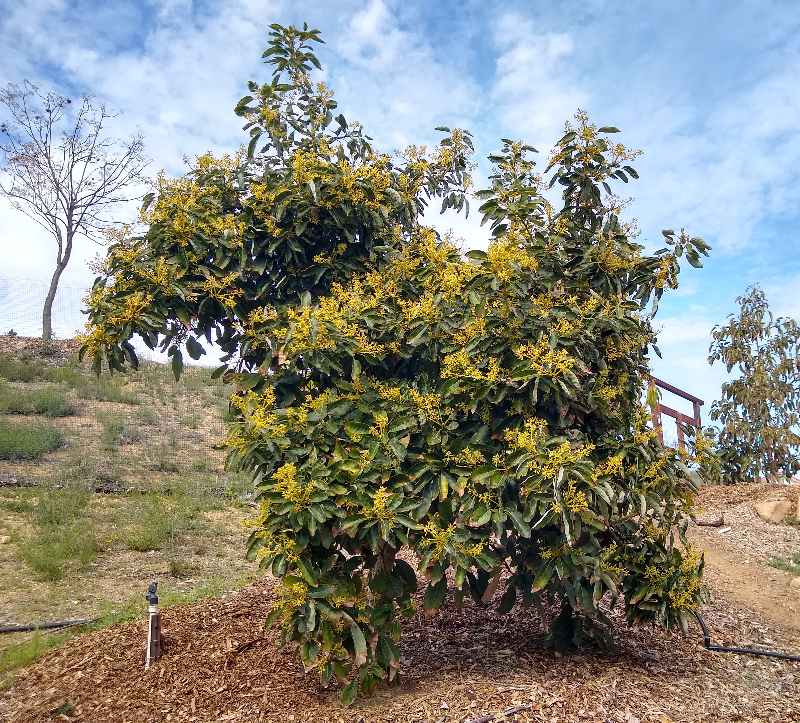
Heat or water stress during or soon after flowering
It is said that avocado pollen loses viability at temperatures of around 95 degrees. And it is said that newly set avocado fruit (the size of BBs or peas) are vulnerable to dropping at about the same temperature. (See here and here.)
So if there’s a heatwave during flowering, an avocado tree can fail to set fruit. And if there’s a heatwave soon after flowering, an avocado tree that set fruit can lose it.
I lost entire, newly set, crops on two trees during a heatwave in early July 2018, when the temperatures got up above 110 degrees.
Some avocado farmers in Israel and Australia and California have erected sprinklers over the tops of their trees in order to cool the trees during high heat during these seasons of vulnerability, and they’ve seen improved crops as a result. (See the California Avocado Society’s June 2022 seminar video on “Heat Mitigation around the World.”)
In addition to heat, mere thirst can stress an avocado tree enough such that it drops some tiny fruitlets too. So if a tree is not being watered enough while its fruit are young (think May, June, and July mostly), then it will drop more of that fruit than it otherwise would.
I had a good number of avocados set on a young Hass tree this spring, and then the irrigation was accidentally turned off on the tree for a few weeks. My fault. The leaves started to brown and every little avocado dropped.
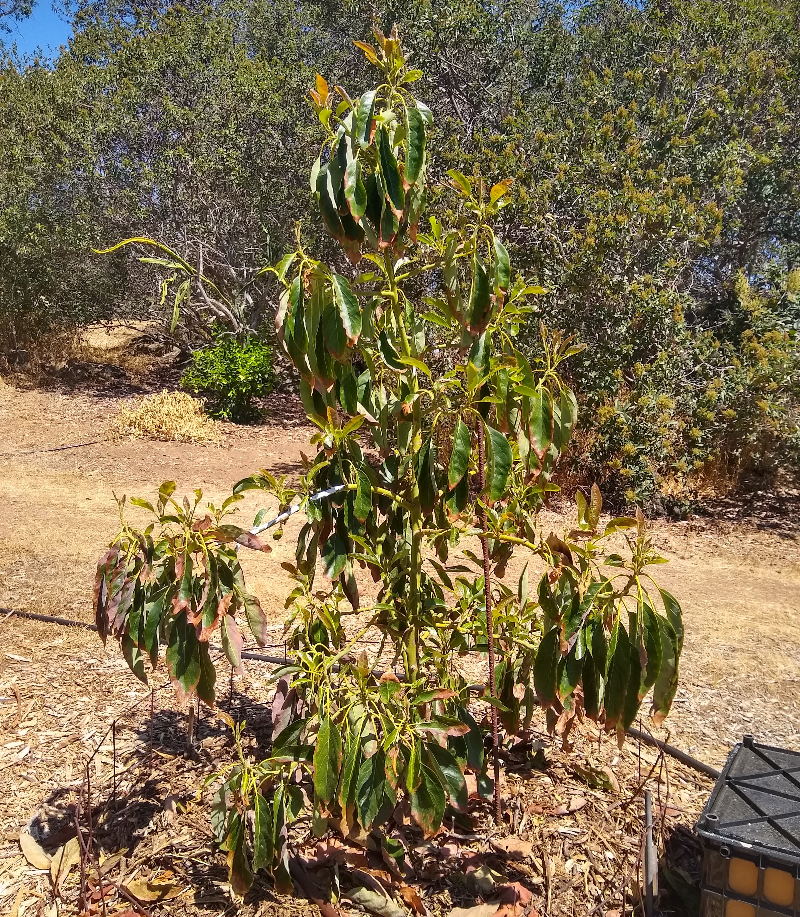
There’s always some fruit drop, but we can do things to help keep it to a minimum, such as making sure the irrigation system is working!
Few bees and flies
The only way avocado flowers become fruit in California is through a visit from an insect, usually a bee and sometimes a fly. If there are few bees and flies around when your avocado tree is in bloom, you can expect few, if any, fruit.
(See the earliest experiments with netting avocado trees to keep in or keep out bees and flies done in Point Loma, San Diego back in the 1920s.)
How many bees might be enough for good fruitset? Gad Ish-Am, a researcher in Israel, concluded that seeing about 40 bees at a given time on a medium-sized tree (which I would guess means about 15 feet tall) while the tree is in full bloom on a warm day is enough. (See details here.)
Why might there be few bees and flies around your tree? Pesticides sprayed in the area can kill them. And they won’t live near your tree if there isn’t food there throughout most of the year; for bees, food means flowers so there must be flowers around for them to feed on.
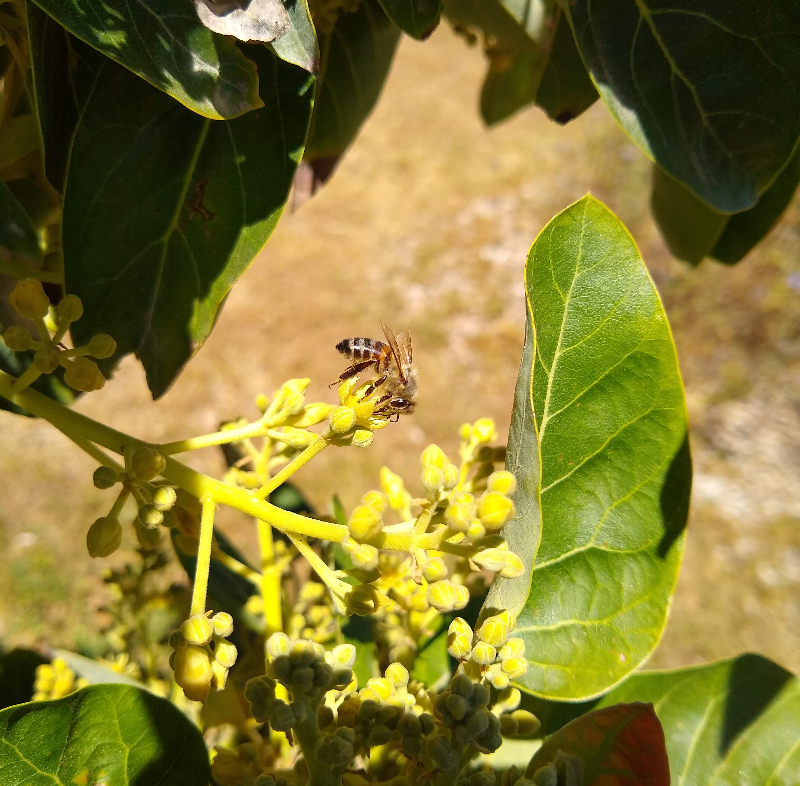
(See my posts, “Growing a bee garden” and “What are the best avocado pollination conditions?” for ideas on increasing populations of bees and flies.)
Rootstocks
Avocado trees bought at a nursery are usually grafted and therefore made of two parts: a rootstock and a scion. I’m not aware of any rootstock that has been found to totally prevent fruit production in the scion (the top part that makes the fruit), but it has been well documented that rootstocks influence the amount of fruit production.
A famous case concerns the rootstock variety Martin Grande, which researchers at U.C. Riverside were very excited about for a time because it was highly resistant to the disease called root rot, only to be abandoned after Hass scions grafted onto Martin Grande (and its seedlings called G755) ended up making only about half as much fruit as those grafted onto other rootstocks. Who cares if the trees don’t decline from root rot if they make few avocados in the meantime, right?
Blaming the rootstock for a tree that barely makes fruit would be my last excuse, but it is a factor and can be the determining factor.
(More on Martin Grande at 1:10 in this video of June 2020 California Avocado Society seminar and in this paper from J.S. Kohne in South Africa.)
(More on avocado rootstocks in general in my post, “Avocado rootstocks: what do they matter?”)
NO, THE TREE DID NOT FLOWER
Now to look into a tree that does not make avocados because it does not make flowers. I see six main reasons.
Seedling, ungrafted
One is that the tree was grown from a seed and has not been grafted. Most avocado trees grown from seed and never grafted take at least five years before flowering. A few rare seedlings flower after only a couple years (seedlings of Pinkerton have been said to do this) while others don’t flower after more than a decade.
In the case of a seedling, you must be patient and wait for your seedling avocado tree to grow through juvenility and be mature enough to reproduce (for that is what making avocado fruit is). Such seedling trees can reach twenty feet tall before they make any flowers.

Young but not precocious
Another reason an avocado tree doesn’t bloom is that it simply is not a precocious variety. Some avocado varieties flower and make fruit earlier in their lives than others. Gwen is a variety that is well known for its early fruiting; it will flower the year after it is grafted. So if you buy a small, grafted Gwen tree, you can expect it to bloom the spring after you put it into the ground. (See such a tree in my video profile of Gwen.)
On the other hand, Sir-Prize is a variety that is slower to come into flowering and fruit production. It might take a couple years before a Sir-Prize tree flowers and makes fruit.
All individual trees are different, but on the whole, varieties are more and less precocious. Don’t expect your Sir-Prize to start flowering and making avocados as soon as your friend’s Gwen did.
Alternate bearing
Varieties also differ in their tendency to produce some fruit every year, although the quantity fluctuates somewhat, or to have years with lots of fruit followed by years with none.
I’ll just use my own Lamb tree as an example. It had zero flowers on it this past spring. Why? Because it was carrying a huge crop of fruit. I’ll harvest that fruit this summer, and then next spring it will most likely flower well and set a crop of avocados that I’ll harvest two summers from now. In other words, it alternates years. It gives flowers and fruit every other year. That’s what Lamb trees around the world tend to do.
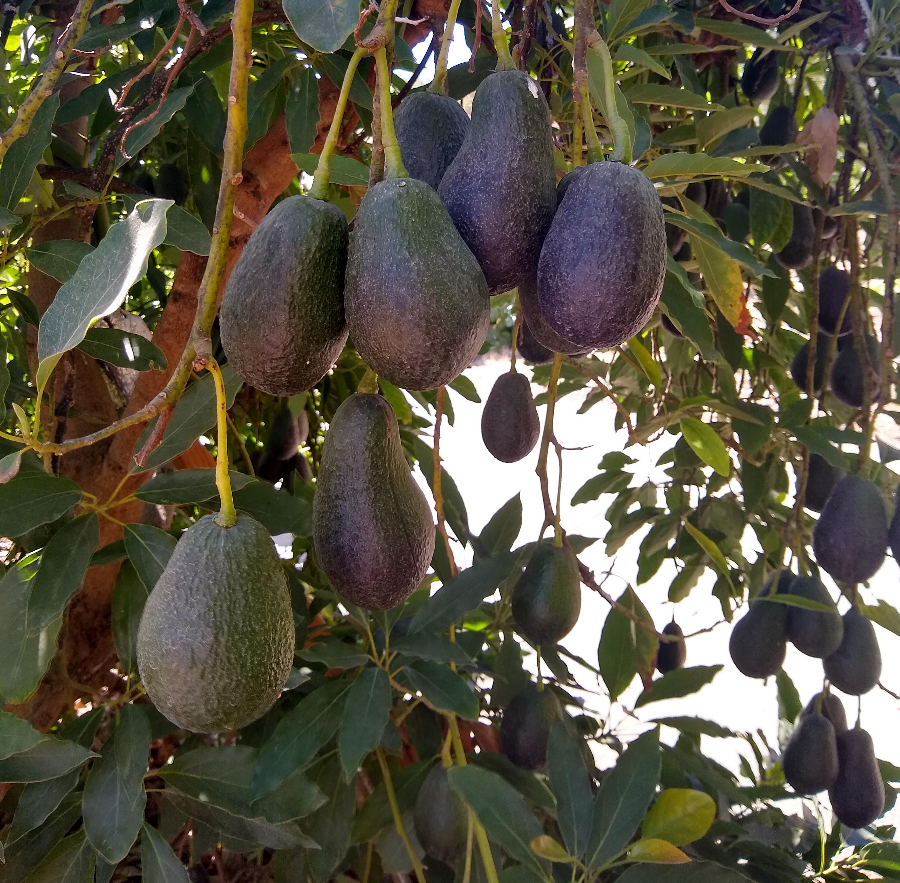
You can just be aware of this habit in your avocado tree or you can see my post on alternate bearing for some ways of counteracting it.
Bad leaf burn
After a year when an avocado tree did not receive as much water as it needed, it will show brown tips on its leaves and leaf edges. Sometimes this starts as early as summer, more often it starts in the fall, and it usually worsens into winter. Then in the spring the tree will spend its energy on growing new leaves to replace the burned, damaged ones rather than make flowers.
The solution to this is to water sufficiently such that the tree goes through a full year of growth with little to no brown on its leaf tips and margins. Then it will make lots of flowers in the following spring, provided there are no other obstacles.
(More on watering avocados here, and on leaf burn specifically here.)
Summer heat damage
Extremely high temperatures during summer can cause an avocado tree to not flower, or to flower much less, the following spring. This happened to some avocado trees in Southern California after a nasty heatwave in early September of 2020, when temperatures reached 115 in many inland locations.
Such high temperatures burn the tips of branches on a tree; the heat essentially fries the outside of the tree’s canopy. Unfortunately, this is the flowering wood that has been fried. It is at and near the tips of branches on the outside of an avocado tree’s canopy where it makes most of its flowers.
So trees that were badly burned in September 2020 had almost no flowering in the spring of 2021. They had to grow new flowering wood through the summer of 2021 and could then be ready for flowering in the spring of 2022.
(There are numerous ways to protect avocado trees from high heat, as explained in my post, “Protecting avocado trees from heat.”)
Winter cold damage
Freeze damage in winter is similar to heat damage in summer in that it prunes off the tips of branches that would be flowering the following spring. Like with summer heat damage, the tree needs a year of growing to make new flowering wood. So after a winter with bad cold damage, you can expect flowering in the second spring.

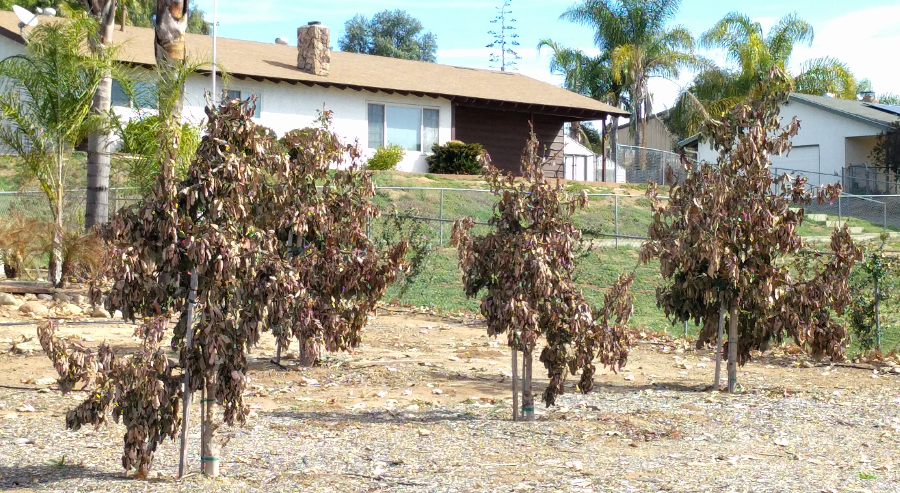
(See my posts on protecting avocados from the cold. Also see my post on how avocado trees flower.)
I’ve thrown a lot of ideas at you in this post. My hope is that if you’ve got an avocado tree that is not fruiting or not fruiting much, some of these ideas will strike you as plausible explanations for your tree’s poor performance. And remember that it’s possible for multiple causes to be colluding in order to keep your tree from fruiting well.
Thanks for reading my Yard Posts. They run purely on your support. Learn how HERE
All of my Yard Posts are listed HERE




I’ve got a Fuerte that bore boatloads of fruit for about 5 years. Then after I neglected it for about two years, I trimmed it up, mulched, watered and fed it. The leaves look very healthy, no trunk burn and a small amount of flowers these past two years now, but no fruit. I’m hoping it’s just ticked off at me and will get over it by next year.
Great post for troubleshooting problems with fruit set.
Glad you mentioned Epicenter. For those of us in NorCal, epicenter is one of the only places where you can find something other than the Hass and Zutano carried by the big box stores. They specialize in trees that will thrive up here and steer you clear of trees that won’t do well at all.
Our Pinkerton kept its leaves, flowered, and is full of fruit with no noticeable fruit drop as of yet. It’s right next to the chicken coop so has tons of fly activity. The Stewart is in the same location, kept it’s leaves and flowered heavily, but had a very early fruit drop and only has a few left on the tree. Our fuerte lost its leaves, made tons of flowers, only had a few set and one stay, which dropped off a few weeks ago. Those are all decent sized juvenile trees that are around 8 feet tall, but only in the ground for a couple of years. We have a lamb that is been paralyzed for years and barely grows and makes no flowers.
Now for the youngsters (sleeves from subtropica that went into the ground a couple of years ago): reed looked like it was about to die and has decided to grow finally, nabal sitting still waiting for encouragement, sharwil sat still until a couple of months ago now it’s growing really well, edranol rooted in under a Catalina cherry tree so I left it there and built a planter around it and despite being a shaded twig three feet tall is carrying 5 fruit with no drop as of yet.
At flower set we had a feral hive that has since left on its own.
Hi Bob,
Your rundown there illustrates how variable trees can perform in the same yard because there are so many factors involved. I could give a similar rundown for the trees in my yard. Sometimes I feel like I know why a tree is performing the way it is and other times I’m puzzled.
It also reminds me of how much more difficult it is to grow an avocado tree in a yard compared to on a farm. Yards have more challenges than farms, such as shade from buildings and trees, and root competition from nearby shrubs and trees.
Somehow between my first post and this one my tiny nabal keeled over and died. Avocados are definitely the most finicky plant I’ve grown (and not grown)
Rats. Sorry, Bob.
Gopher?
So sad. I tasted my first nabal recently. It was gigantic, and outstanding texture and flavor. I’d love to have one.
Hi Greg, Have you got any posts about fertilizing avocados? I couldn’t find any. Thanks!
Hi Louis,
Yes, here is my post on fertlizing avocado trees: https://gregalder.com/yardposts/fertilizing-avocado-trees/
I got a Sharwil which is frustrating me. Its from LaVerne, probably Zutano rootstock. I bought it in a 7 gallon container and it is growing beautifully but it hasn’t flowered in the 2 years since I got it. I live in Los Angeles. Arguably, it is my nicest tree and I am praying it flowers early next year. I have 3 Reeds, 2 GEM, a Carmen, and they have all flowered. Recently I picked up a young Jan Boyce, another Sharwil (Brokaw) and a Gwen (Brokaw) thanks to your recommendation, Greg! I don’t think I have anymore room left. I may be able to squeeze a Lamb or Holiday in a corner somewhere 🙂
Well, Byron, if you have all those other varieties producing you’re going to be in avocado heaven. Lamb is nice, but I wouldn’t waste your leftover space on a Holiday. As for Sharwil, I know of some Sharwils in Southern California that produce OK, but I don’t know any that produce nearly as consistently as your others (Reed, GEM, Carmen, Jan Boyce, Gwen). I have a couple young Sharwils myself and they follow the same trend. But the fruit is so good! I hope yours breaks the mold.
I have noticed this for the past three years now the mean temp. not getting that magic number of 68 and the flowers don’t pollinate. Three years of a cold spring and the only tree that has fruit on it right now is a three year old Reed that managed to flower in April and after asking a few that grow Reeds this is their time frame not March. So those of us with this colder spring situation might have to start growing Reeds. My Hass, Mexicola Granda, Fuerte all dropped the flowers in March. I have a few seedlings that dropped flowers as well but they could still be a bit young yet. My experiment trying to grow 5 miles from the coast has been a long and difficult journey not just all the avocado, but the guava now finally flowering so late. It’s a been a challenge climate change. So What I am going to do this next winter is NOT fertilizer for Spring in hopes the trees don’t open in March. Right now the Pears, apples and apricots were good, cherimoya we just hand pollinated but it’s a bit late as well. The White Sapote is ok because that one flowers in the fall. Finding the trees that can flower in later spring might be our answer.
Hi Tina,
I’m curious to learn where you’re at (five miles from which beach?). I also find that Reed is reliably pollinated in my yard since my nights are chilly and I don’t get high means until late in spring. Nevertheless, at least for your Fuerte and Hass, as the trees get bigger their bloom season should get longer such that they will continue flowering into May (or so, depending on where you live). Mine both go into May. (Reed goes all the way into early July for me.) So maybe with time they’ll set fruit better.
I’ve got a hass that finally has a decent number of avocados – maybe 15. The curious thing to me is they are of very different sizes. The biggest already almost fill my palm, but then others are still very small. Will they catch up? Or will I end up with some really tiny ones that aren’t worth much?
Thanks as always for the great content.
Hi Brandon,
They might be different sizes just based on when they started growing. Some might have been pollinated in March while others weren’t pollinated until May, for example.
But let’s do this. Tag a few of the fruit that are exceptionally big or small now and see if they end up remaining that way at harvest time. I’ll do the same on some of my trees.
Great suggestion. Thanks Greg!
Hi Greg, I found your site through the UC Master Gardeners in Santa Clara. Great info!
My home came with an avocado tree, grown from a seed. It had severe leaf tip burn. I overwatered this past spring and the brown leaves fell off and tons of beautiful new growth grew. It looks very healthy. It’s approx six feet tall. It’s never fruited per the previous home owners and has not fruited in the two years I’ve lived here.
Do you think girdling the tree could encourage flowers next spring? I think the tree is approx 5 or 6 years old, so I’m hopeful blooms are just around the corner. Thank you!
Hi Ally,
Thanks! I think that girdling could induce the tree to bloom but it is not certain. It’s worth a try though, and if done correctly, it doesn’t damage the tree in any permanent way. I would try as long as the tree is healthy. Here is a study done on the subject in Israel: http://avocadosource.com/Journals/HortScience/HortSci_1986_21_PG_1038-1039.pdf
Our well 10+ year old Fuerte in Chino, CA produces avocados, but during the ripening process they get black spots. They seem to go from hard to rotten with black spots immediately. The flavor of the ones we have managed to salvage is minimal. Thoughts?
Hi Pam,
Do the black spots appear before you harvest or after? Are they near the stem only, bottom only, or all over the fruit?
You might like to try to find the cause and cure here: https://www2.ipm.ucanr.edu/agriculture/avocado/fruit-and-stem-end-rots/
Great Post!..In addition,lone trees won’t set fruit in warmer regions
Good stuff, Greg. I have six relatively young trees, 3 Hass, 2 Feurte, 1 Zutano. Last year and this year they all flowered. They all made little pin head sized avocados, 20-40 at least. A few made it to pea size and one or two per tree made it to grape size. By Mid may I had zero. I couldn’t even find the grape sized ones on the ground. Do rats eat them off the tree? (yes, I have rats.) I water regularly using the DIG sprayers you recommended. Some of my Hass have/had leaf burn, but the B types foliage looks very healthy (green, lush.) really would like to live long enough to get ONE avocado. I am in Anaheim hills. It does get hot some days – I try to cool the tree off using ideas you mentioned from Redlands (much hotter than here.)
Hi Alan,
Anaheim Hills is a great place to grow avocados. I don’t know if rats will eat those little fruitlets, but I wouldn’t be surprised if they did. If the fruit were just dropping, then you should notice them on the ground as they don’t dry up and “disappear” for a couple days after dropping.
I received 3 feral cats 1yr old ea.. from a Feral Rescue Group. And I have no problem with rats, mice, birds, & even squirrels at tim the cats have killed squirrels also. Squirrels are the only menace to my fruit trees. And many neighbors have shot them.. & we have very few Now.
None of my avos have ever set significant fruit. We’ve been here 9 years now. Well, a couple have, but they dropped most of them as fruitlets. My recently planted lamb set a lot of babies which I removed. Otto & Sons nursery recommended to customers plant several fruit trees in one large hole. We planted 4 avos in separate holes, but quite close together in a 4ft square. They all thrived and really took off when we changed our irrigation to something less stingy. One is limping, having gotten sunburnt a few years ago. The other three we’ve had to cut back to keep them from growing toward our power lines. We’ve had good luck shading outr trees w a cast off patio umbrella and large shade sails. This year they’re fine without.
But after 8-9 years I’ve harvested a hass or two and several bacons. A few Pinkerton one year. There are 3 bacons on my 10 ft tree at the moment. Our avos were chronically under watered in their first 3 years. Permanent damage? They now look very happy and bloomed like crazy. Our yard always hums w bees thanks to the agricultural beekeeper neighbors.
What do you think of the multi-planting in one hole idea? Something still isn’t working, and like many folks we are surrounded by avo ranches.
Hi Helena,
Sounds like underwatering could have been the cause of problems earlier. Trees can recover from this, but there may have been permanent sunburn damage. Sufficient recovery to carry a crop can take more than one year of proper watering.
It can be misleading to look at your trees here in August and assume you’re watering enough because they look decent. How they look in December tells the real story. If the trees still have almost totally green leaves in December, then you know that you watered enough the previous summer.
Planting multiple trees in one hole can work. See examples in this post: https://gregalder.com/yardposts/how-far-apart-to-plant-avocado-trees/
Hi Greg, I just found your web site and am very happy! Thanks for sharing all this great information. Here is my question up front and then some background: how often will a Fuerte tree be barren?
I live in northeast Vista (not too far from you) and am lucky to have a good size backyard. In 2018 we planted 5 fuerte trees. They have all been flowering for a few years now but only ONE of the 5 Fuerte trees has ever set fruit, and very few. A few years ago one fruit grew to a good size, a bit larger than a large supermarket avo, and was good eating.
After doing some research on avocados, about 2 years ago I put in a Hass. Last year it flowered but no fruit on it, and again one lonely avo on the same Fuerte tree. But as I write this in late May 2024 I have many dozens of pinhead or small pea size fruit on the Haas and the same Fuerte tree. Still nothing on the other 4 Fuerte trees. Seems it may be time to swap them for a different variety? Thanks for any info you can provide!
Hi Pete,
Thanks very much for your support!
I feel your pain! I’ve got a barren Fuerte that I planted in 2013: still not a single fruit from it. I’ve seen many others. This happens with Fuerte far more than any other avocado variety I know.
See my profile of the Fuerte variety: https://gregalder.com/yardposts/the-fuerte-avocado-tree-a-profile/
What to do? You can give your trees a little more time, but I wouldn’t give them much. If I were you, I would graft the four that have yet to produce over to different varieties sooner rather than later.
Easier said than done, I know. Can you graft? Can you procure budwood? You might have to pay someone to accomplish these tasks.
Alternatively, plant new trees of different varieties later this spring or next year if the four Fuertes haven’t set any fruit.
The only caveat I would make is that this spring and the last have been exceptionally cool and not conducive to Fuerte fruitset. It may be that your Fuertes will set some or much more in years with warm springs. So you could wait for next spring to see if it’s a warmer one and what happens then.
Thanks for responding Greg. My four “problem trees” are quite healthy and well established – trunk diameters ranging from 2.5 to 3 inches and about 8-10 feet tall. It would be a shame to start from scratch so grafting seems like the way to go, but I don’t want to attempt that. And since one of the Fuerte trees is now setting a LOT of fruit (along with it’s Hass neighbor) I think it’s time to make a change with the other trees. I am hoping some of the fruit will reach maturity, I am closely reading your other posts to help with that.
Can you suggest a good person or nursery to help with the grafting? Thanks!
Hi Peter,
I don’t know of anyone who grafts on a small scale, only professional grafters who work on thousands of trees for farmers. But I think you should inquire at Maddock Ranch Nursery near you in Fallbrook and see if they can get you a contact: https://www.maddockranchnursery.com/
Secondly, you might get in touch with folks at the California Rare Fruit Growers, North San Diego County chapter to see if they can connect you with someone: https://growrarefruit.org/
I have two Fuerte’s that have grown strong and healthy. Both, though, will only give me a few avocados per year. They are around nine years old. Limited flowering. I have 23 avocado trees with 11 different varieties and plenty of bee activity. Any thoughts how I could get more flowers/avocados? Thanks Greg!
Hi Curtis,
If they were my trees, I would girdle them this fall. If they didn’t respond to the girdling with abundant flowering and fruitset, then I would cut them back and graft them over to another variety.
If that sounds like something you’d like to try, let me know and I’ll point you to resources.
What causes banana avocados on my trees with big avicados also?
Hi Greg,
Thank you for sharing your knowledge. I bought a large Fuerte avocado tree from Durling Nursery recently. Although the tree trunk is large, there are no flowers on it. I have a nearby Hass that is much smaller and there are a good amount of fruits. I was told it could be a ‘male’ avocado. Is this possible? And will i ever get it to flower and fruit?
Hi Paul,
There is no such thing as a male avocado tree so I would disregard anything further from that source of information.
Right now, June 21, you should not expect to see any flowers on a Fuerte tree. The next time it might make flowers is the very end of summer, at the earliest, but more likely not until winter.
Hass is a more precocious variety than Fuerte. On average, Hass trees fruit at a younger age than Fuerte trees. So what you’re seeing with your trees is normal.
Fuerte is a quirky variety though, and there are Fuerte trees that fruit incredibly well but also Fuerte trees that make almost no fruit. See my profile for more on this: https://gregalder.com/yardposts/the-fuerte-avocado-tree-a-profile/
I hope you have one that will make loads of fruit!
Good morning Greg.
My name is Armando Franco. I live in the city of La Habra Heights, Ca.
I have grown a number of avocados from seed with success. My question is about one in particular.
This tree flowers abundantly. It produces hundreds of buds. Only a small number of them mature. The most was 5 three years ago. The remaining ones never grow beyond 3 inches and grow rings on the fruit as they decay.
I have no idea why. Please advise.
Sincerely,
Armando Franco